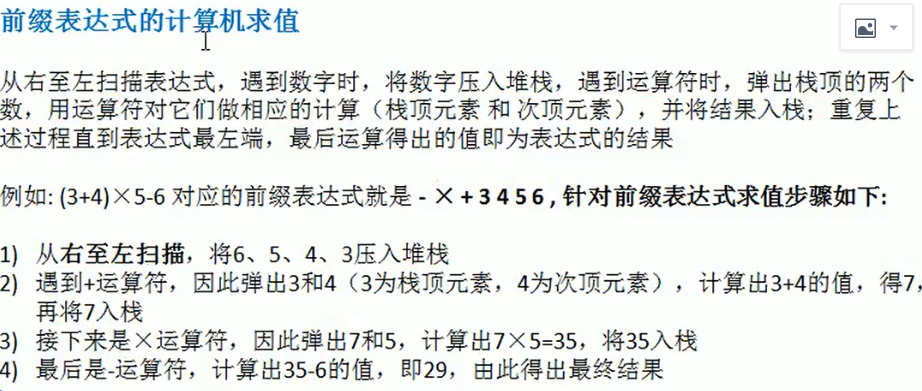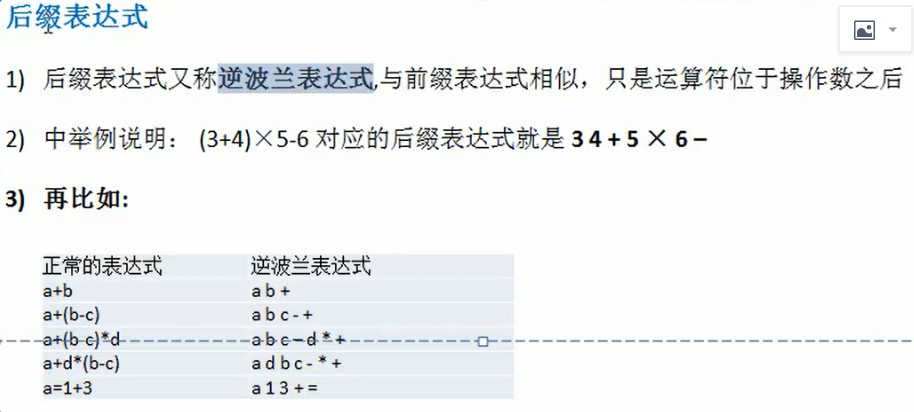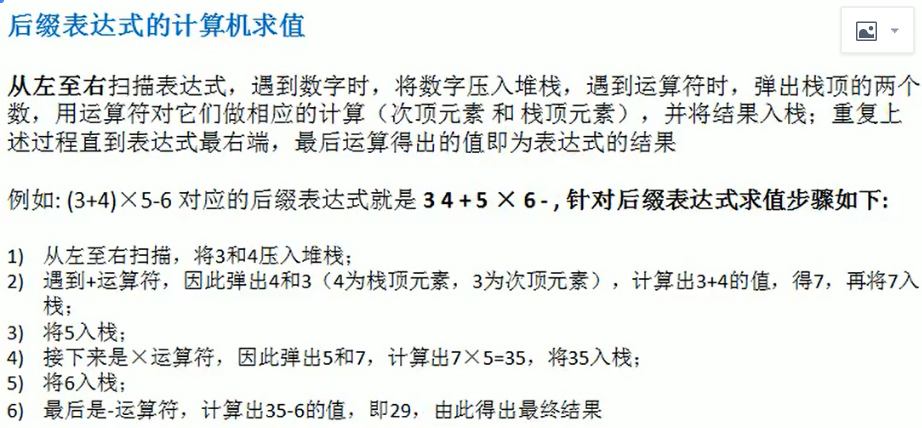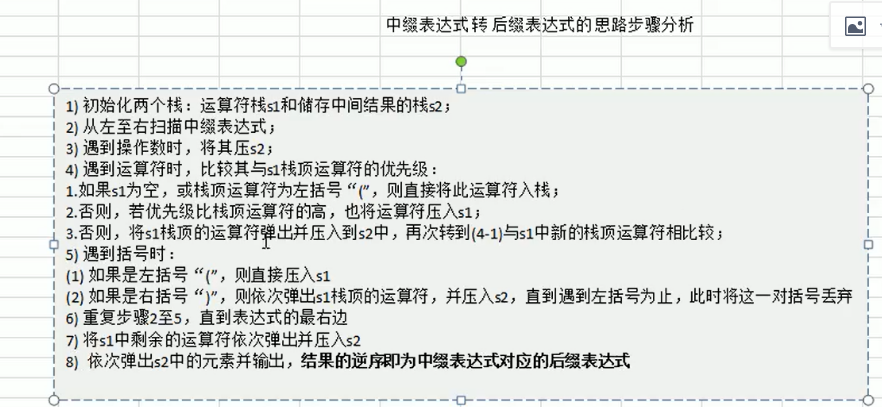先简单介绍几个概念:
1.前缀表达式

2.中缀表达式

3.后缀表达式


4.中缀表达式转后缀表达式的流程:

代码实现:
用于计算中作为存储结构的栈:
package com.vi.algorithm.stack; import com.vi.algorithm.linear.LinkList; // 计算器栈,用于实现加减乘除的计算器,在链表实现的栈的基础上,对功能做扩展 public class CalculateStack<T> extends LinkListStack<T> { public CalculateStack() { } // 判断当前元素是否操作符 public static boolean isCommand(String str) { return str.matches("[\+\-\*\/]"); } // 判断当前操作符的优先级 public static int priority(String str) { if ("+".equals(str)) return 0; if ("-".equals(str)) return 1; if ("*".equals(str) || "/".equals(str)) return 2; if("(".equals(str) || ")".equals(str)) return -1; throw new RuntimeException("非法操作符"); } public static void main(String[] args) { // System.out.println(new CalculateStack<>().isCommand("\")); CalculateStack<Integer> cs = new CalculateStack<>(); cs.push(1); cs.push(2); cs.push(3); System.out.println(cs.peek()); cs.list(); } }
实现栈用到的两个类:

1 package com.vi.algorithm.stack; 2 3 import com.vi.algorithm.linear.LinkList; 4 5 // 用链表实现栈 6 public class LinkListStack<T> { 7 private LinkList<T> stack; 8 9 public LinkListStack() { 10 stack = new LinkList<>(); 11 } 12 13 // 链表式的不存在存满的情况 14 public boolean isFull() { 15 return false; 16 } 17 18 // 判断是否为空 19 public boolean isEmpty() { 20 return stack.length() == 0; 21 } 22 23 public T pop() { 24 if (stack.isEmpty()) { 25 System.out.println("栈为空!"); 26 return null; 27 } 28 T result = stack.remove(stack.length() - 1); 29 return result; 30 } 31 32 public boolean push(T data) { 33 try { 34 stack.insert(data); 35 } catch (Exception e) { 36 System.out.println("插入失败!"); 37 return false; 38 } 39 return true; 40 } 41 42 // 查看栈顶元素但是不弹出 43 public T peek() { 44 return stack.get(stack.length() - 1); 45 } 46 47 // 遍历 48 public void list() { 49 if (stack.isEmpty()) { 50 System.out.println("栈为空!"); 51 return; 52 } 53 for (int i = stack.length() - 1; i >= 0; i--) { 54 System.out.printf("stack[%d] = %d ", i, stack.get(i)); 55 } 56 } 57 }
链表:

1 package com.vi.algorithm.linear; 2 3 import java.util.Iterator; 4 5 /** 6 * 单向链表 7 */ 8 public class LinkList<T> implements Iterable<T> { 9 // 头结点 10 private Node<T> head; 11 // 链表长度 12 private int length; 13 14 public LinkList() { 15 head = new Node<>(null, null); 16 length = 0; 17 } 18 19 // 内部类,节点类型 20 private class Node<T> { 21 T data; 22 Node next; 23 24 public Node(T data, Node next) { 25 this.data = data; 26 this.next = next; 27 } 28 29 @Override 30 public String toString() { 31 return "Node{" + 32 "data=" + data + 33 ", next=" + next + 34 '}'; 35 } 36 } 37 38 // 清空链表 39 public void clear() { 40 if (head == null) 41 return; 42 head.next = null; 43 length = 0; 44 } 45 46 // 判断链表是否为空 47 public boolean isEmpty() { 48 return length == 0; 49 } 50 51 // 获取链表中元素的个数 52 public int length() { 53 return length; 54 } 55 56 // 获取第i个元素的值 57 public T get(int i) { 58 if (head == null) 59 return null; 60 Node cursor = head; 61 for (int index = 0; index <= i; index++) { 62 if (cursor.next != null) 63 cursor = cursor.next; 64 else 65 throw new RuntimeException("下标越界"); 66 } 67 return (T) cursor.data; 68 } 69 70 // 在链表索引i处插入元素t 71 public void insert(int i, T t) { 72 if (head == null) 73 return; 74 Node cursor = head; 75 76 int index = 0; 77 while (index <= i - 1) { 78 if (cursor != null) { 79 cursor = cursor.next; 80 } else 81 throw new RuntimeException("下标越界"); 82 index++; 83 } 84 85 if (cursor != null) { 86 if (cursor.next != null) { 87 Node newNode = new Node(t, cursor.next); 88 cursor.next = newNode; 89 } else { 90 Node newNode = new Node(t, null); 91 cursor.next = newNode; 92 } 93 length++; 94 } 95 } 96 97 // 在链表最后的位置插入一个元素 98 public void insert(T t) { 99 if (head == null) 100 return; 101 102 insert(length, t); 103 } 104 105 // 删除链表中索引i处的元素并返回 106 public T remove(int i) { 107 if (head == null) 108 return null; 109 Node cursor = head; 110 for (int index = 0; index <= i - 1; index++) { 111 if (cursor.next == null) 112 throw new RuntimeException("下标越界"); 113 cursor = cursor.next; 114 } 115 116 if (cursor.next == null) { 117 return null; 118 } else { 119 Node target = cursor.next; 120 Node next = target.next; 121 cursor.next = next; 122 target.next = null; 123 length--; 124 return (T) target.data; 125 } 126 } 127 128 // 查找t在链表中的索引位置,如果不存在返回-1 129 public int indexOf(T t) { 130 Node cursor = head.next; 131 int index = 0; 132 while (cursor != null) { 133 if (cursor.data.equals(t)) { 134 return index; 135 } 136 index++; 137 cursor = cursor.next; 138 } 139 return -1; 140 } 141 142 @Override 143 public Iterator<T> iterator() { 144 return new Literator(); 145 } 146 147 private class Literator implements Iterator { 148 Node cursor; 149 150 public Literator() { 151 cursor = head; 152 } 153 154 @Override 155 public boolean hasNext() { 156 return cursor.next != null; 157 } 158 159 @Override 160 public Object next() { 161 cursor = cursor.next; 162 return cursor; 163 } 164 } 165 }
将中缀表达式转成后缀表达式以及计算表达式的值

1 package com.vi.algorithm.demo; 2 3 import com.vi.algorithm.stack.CalculateStack; 4 5 import java.math.BigDecimal; 6 import java.util.ArrayList; 7 import java.util.Arrays; 8 import java.util.List; 9 import java.util.Stack; 10 11 // 波兰表达式计算(后缀表达式) 12 public class PolandCalculations { 13 public static void main(String[] args) { // 1+(2*3)+4 14 String expression = infixToSuffix("3.1+4.2*5.6-4.6"); 15 System.out.println(expression); 16 System.out.println("计算的结果是:"+calculate(expression)); 17 } 18 19 // 多位正浮点数计算 20 public static float calculate(String expression) { 21 // (30+4)*5-6 -> 30 4 + 5 * 6 - 22 String[] target = expression.split(" "); 23 List<String> strings = Arrays.asList(target); 24 Stack<String> numberStack = new Stack<>(); 25 for (String str : strings) { 26 if (str.matches("[\+\-\*\/]")) { 27 // 如果是运算符,从数栈中弹出两个数进行计算 28 BigDecimal num2 = new BigDecimal(numberStack.pop()); 29 BigDecimal num1 = new BigDecimal(numberStack.pop()); 30 float result = calculate(num1, num2, str); 31 // 把计算出的结果压入数栈 32 numberStack.push(result + ""); 33 } else { 34 // 如果是运算符,压入数栈 35 numberStack.push(str); 36 } 37 } 38 return Float.parseFloat(numberStack.pop()); 39 } 40 41 private static float calculate(BigDecimal num1, BigDecimal num2, String str) { 42 if ("+".equals(str)) 43 return num1.add(num2).floatValue(); 44 if ("-".equals(str)) 45 return num1.subtract(num2).floatValue(); 46 if ("*".equals(str)) 47 return num1.multiply(num2).floatValue(); 48 if ("/".equals(str)) 49 return num1.divide(num2).floatValue(); 50 throw new RuntimeException("非法的操作符"); 51 } 52 53 /** 54 * 中缀表达式转后缀表达式,假设输入的中缀表达式都是符合规范的 55 * 思路: 56 * 1.准备两个栈,一个s1存操作符,另一个s2存处理以后的表达式 57 * 2.遍历中序表达式,遇到数,压入s2栈,遇到操作符进行判断,如果s1为空,直接压入s1,如果不为空,判断是否"(","("直接压入 58 * 3.判断是否")",如果是,弹出s1中的元素,依次压入s1栈,直至遇到"(",将"("弹出 59 * 4.如果不是以上情况,则判断当前运算符的优先级是否高于栈顶运算符的优先级,如果高于栈顶,把当前运算符压入s1,如果低于栈顶,把栈顶弹出压入s2,依次和新栈顶继续比较 60 * 5.遍历结束,把s1元素弹出依次压入s2,倒序输出s2元素,即转换后的后缀表达式 61 * 62 * @param infixExpression 63 * @return 64 */ 65 private static String infixToSuffix(String infixExpression) { 66 // 把字符串表达式转换成列表 67 int index = 0; 68 ArrayList<String> list = new ArrayList<>(); 69 // 把运算符存进列表 70 while (index < infixExpression.length()) { 71 if (infixExpression.substring(index, index + 1).matches("[()\+\-\*\/]")) { 72 list.add(infixExpression.substring(index, index + 1)); 73 } else { 74 // 把操作数存进列表 75 String num = infixExpression.substring(index, index + 1); 76 while (index != infixExpression.length() - 1 && !infixExpression.substring(index + 1, index + 2).matches("[()\+\-\*\/]")) { 77 index++; 78 num = num + infixExpression.substring(index, index + 1); 79 } 80 list.add(num); 81 } 82 index++; 83 } 84 // 准备一个栈存放运算符 85 CalculateStack<String> stack = new CalculateStack<>(); 86 // 准备一个列表存放结果 87 ArrayList<String> result = new ArrayList<>(); 88 // 顺序遍历集合 89 for (int i = 0; i < list.size(); i++) { 90 if (!list.get(i).matches("[()\+\-\*\/]")) { 91 // 如果不是运算符,直接存入result 92 result.add(list.get(i)); 93 } else { 94 // 如果是运算符 95 if (stack.isEmpty()) { 96 // 栈为空,直接压入 97 stack.push(list.get(i)); 98 } else if ("(".equals(list.get(i))) { 99 // 如果是左括号,直接压入 100 stack.push(list.get(i)); 101 } else if (")".equals(list.get(i))) { 102 // 如果是右括号,弹出栈顶元素直到"(" 103 while (!"(".equals(stack.peek())) { 104 result.add(stack.pop()); 105 } 106 stack.pop(); 107 } else { 108 // 判断运算符优先级 109 if (CalculateStack.priority(list.get(i)) > CalculateStack.priority(stack.peek())) { 110 stack.push(list.get(i)); 111 } else { 112 while (!stack.isEmpty() && CalculateStack.priority(stack.peek()) >= CalculateStack.priority(list.get(i))) { 113 result.add(stack.pop()); 114 } 115 stack.push(list.get(i)); 116 } 117 } 118 } 119 } 120 while (!stack.isEmpty()) { 121 result.add(stack.pop()); 122 } 123 // 把列表转成字符串 124 final String[] str = {""}; 125 result.forEach(ele -> { 126 str[0] = str[0] + ele +" "; 127 }); 128 return str[0].substring(0,str[0].length()-1); 129 } 130 }
运行结果如下:

当前代码并不支持负数的计算,如果要加入对负数的运算,可以先把中缀表达式处理一下,例如:判断开头是否有负数,如果有将 -99之类的负数转成(0-99),再将表达式其他的(-xx)这样的项数替换成(0-99),
再转换成后缀表达式计算即可。
